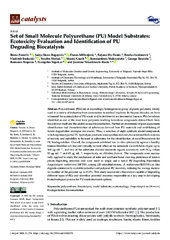Приказ основних података о документу
Set of Small Molecule Polyurethane (PU) Model Substrates: Ecotoxicity Evaluation and Identification of PU Degrading Biocatalysts
| dc.creator | Pantelić, Brana | |
| dc.creator | Škaro Bogojević, Sanja | |
| dc.creator | Milivojević, Dušan | |
| dc.creator | Ilić-Tomić, Tatjana | |
| dc.creator | Lončarević, Branka | |
| dc.creator | Beskoski, Vladimir | |
| dc.creator | Maslak, Veselin | |
| dc.creator | Guzik, Maciej | |
| dc.creator | Makryniotis, Konstantinos | |
| dc.creator | Taxeidis, George | |
| dc.creator | Siaperas, Romanos | |
| dc.creator | Topakas, Evangelos | |
| dc.creator | Nikodinović-Runić, Jasmina | |
| dc.date.accessioned | 2023-03-13T10:44:47Z | |
| dc.date.available | 2023-03-13T10:44:47Z | |
| dc.date.issued | 2023 | |
| dc.identifier.issn | 2073-4344 | |
| dc.identifier.uri | https://www.mdpi.com/2073-4344/13/2/278 | |
| dc.identifier.uri | https://imagine.imgge.bg.ac.rs/handle/123456789/1790 | |
| dc.description.abstract | Polyurethanes (PUs) are an exceedingly heterogeneous group of plastic polymers, widely used in a variety of industries from construction to medical implants. In the past decades, we have witnessed the accumulation of PU waste and its detrimental environmental impacts. PUs have been identified as one of the most toxic polymers leaching hazardous compounds derived both from the polymer itself and the additives used in production. Further environmental impact assessment, identification and characterization of substances derived from PU materials and establishing efficient degradation strategies are crucial. Thus, a selection of eight synthetic model compounds which represent partial PU hydrolysis products were synthesized and characterized both in terms of toxicity and suitability to be used as substrates for the identification of novel biocatalysts for PU biodegradation. Overall, the compounds exhibited low in vitro cytotoxicity against a healthy human fibroblast cell line and virtually no toxic effect on the nematode Caenorhabditis elegans up to 500 µg mL−1, and two of the substrates showed moderate aquatic ecotoxicity with EC50 values 53 µg mL−1 and 45 µg mL−1, respectively, on Aliivibrio fischeri. The compounds were successfully applied to study the mechanism of ester and urethane bond cleaving preference of known plastic-degrading enzymes and were used to single out a novel PU-degrading biocatalyst, Amycolatopsis mediterranei ISP5501, among 220 microbial strains. A. mediterranei ISP5501 can also degrade commercially available polyether and polyester PU materials, reducing the average molecular number of the polymer up to 13.5%. This study uncovered a biocatalyst capable of degrading different types of PUs and identified potential enzymes responsible as a key step in developing biotechnological process for PU waste treatment options. | |
| dc.language | en | |
| dc.relation | This work was supported by the European Union’s Horizon 2020 Research and Innovation Programme under grant agreement No. 870292 (BioICEP) and by the National Natural Science Foundation of China (Nos. 31961133016, 31961133015, and 31961133014). | |
| dc.rights | openAccess | |
| dc.rights.uri | https://creativecommons.org/licenses/by/4.0/ | |
| dc.source | Catalysts | |
| dc.source | Catalysts | |
| dc.subject | Amycolatopsis mediterranei | |
| dc.subject | biocatalysis | |
| dc.subject | biodegradation | |
| dc.subject | bioremediation | |
| dc.subject | ecotoxicology | |
| dc.subject | model substrate | |
| dc.subject | polyurethane | |
| dc.title | Set of Small Molecule Polyurethane (PU) Model Substrates: Ecotoxicity Evaluation and Identification of PU Degrading Biocatalysts | |
| dc.type | article | en |
| dc.rights.license | BY | |
| dc.citation.issue | 2 | |
| dc.citation.rank | M22~ | |
| dc.citation.spage | 278 | |
| dc.citation.volume | 13 | |
| dc.description.other | Supplementary material: [https://imagine.imgge.bg.ac.rs/handle/123456789/1792] | |
| dc.identifier.doi | 10.3390/catal13020278 | |
| dc.identifier.fulltext | https://imagine.imgge.bg.ac.rs/bitstream/id/113949/Set_of_Small_Molecule_Polyurethane_PU_Model_Substrates_Ecotoxicity_Evaluation_and_Identification_of_PU_Degrading_Biocatalysts_2023.pdf | |
| dc.identifier.scopus | 2-s2.0-85149108994 | |
| dc.type.version | publishedVersion |

